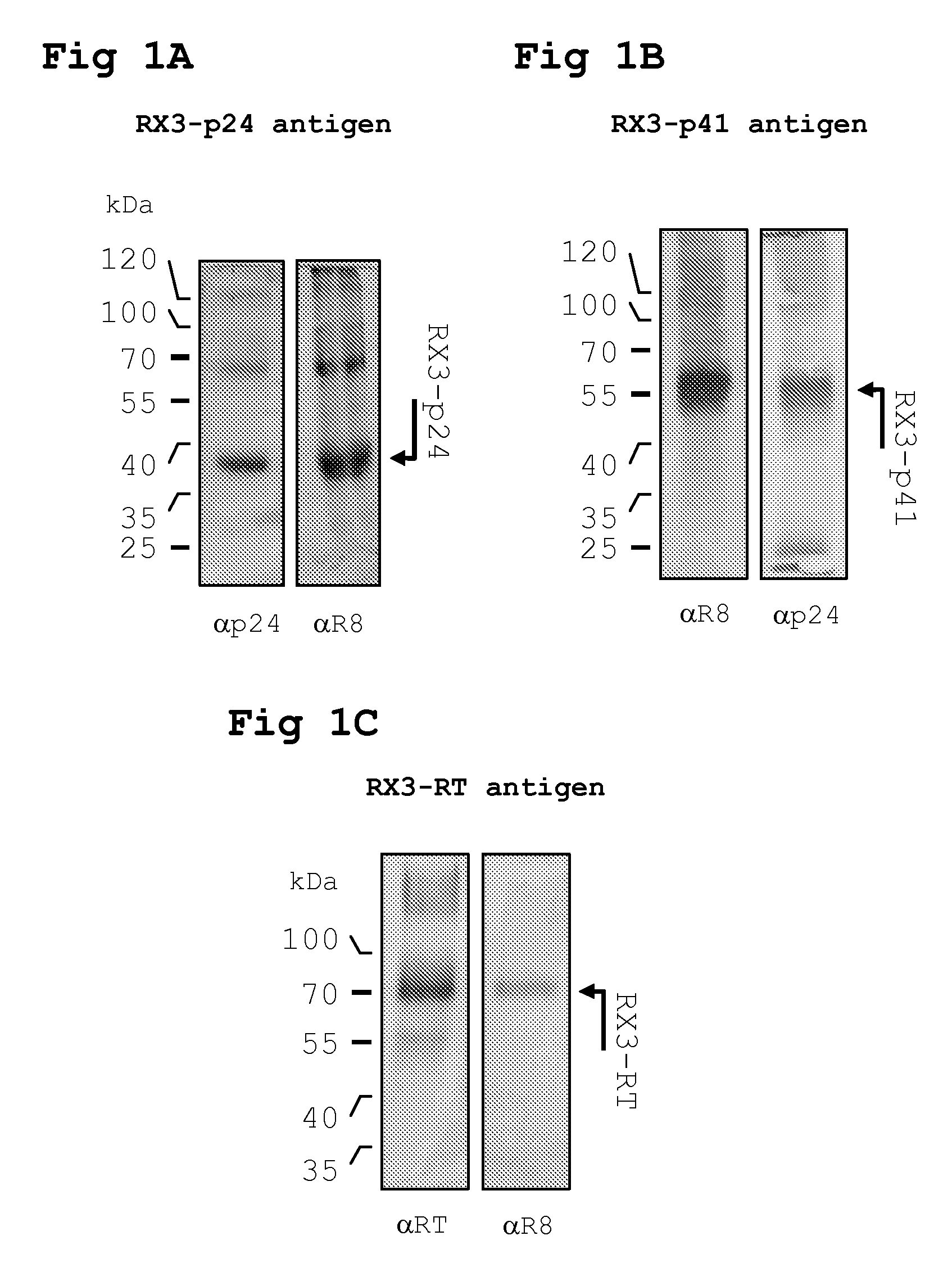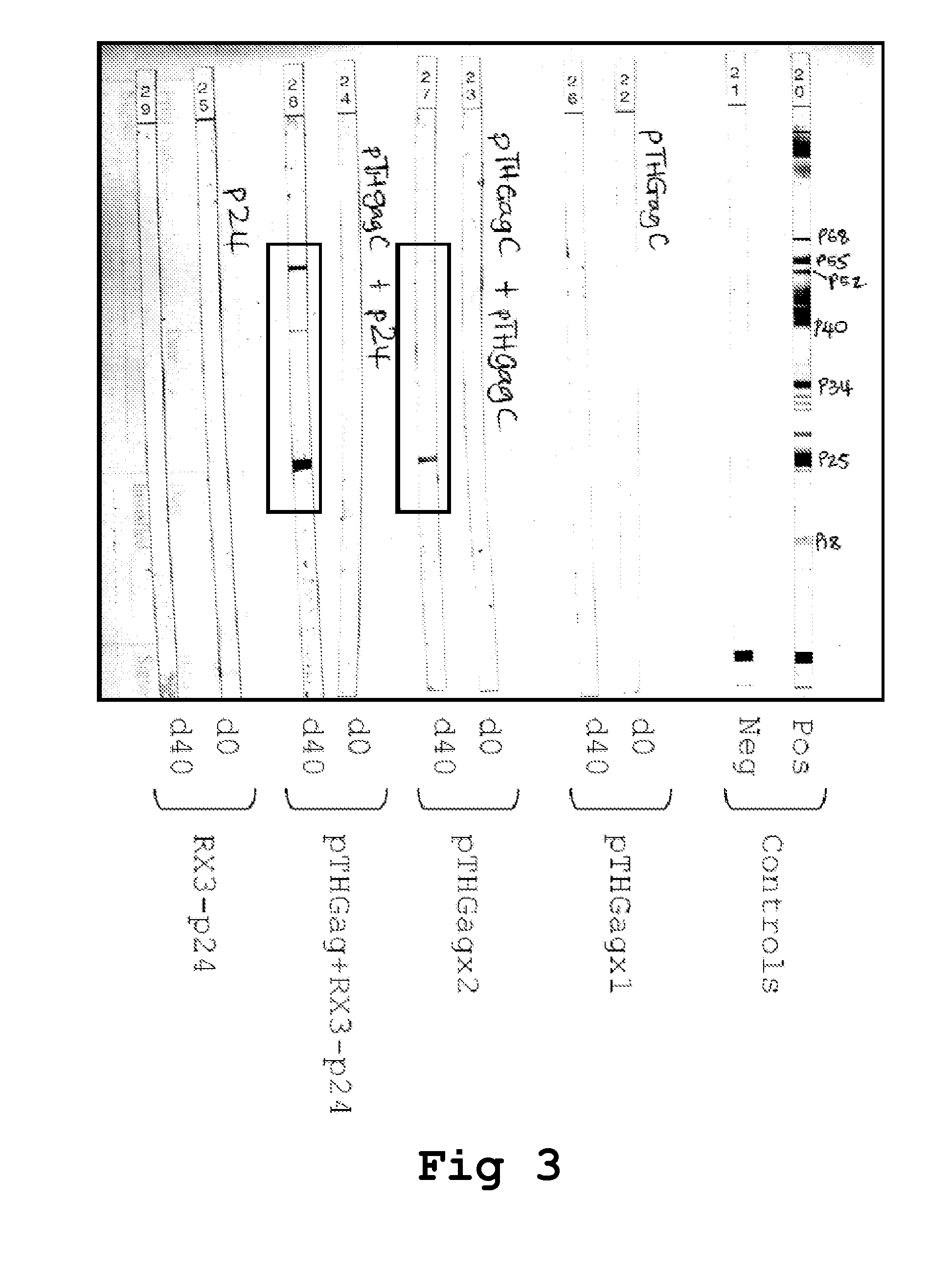Recombinant Protein Bodies as Immunogen-Specific Adjuvants
a protein body and immunogen technology, applied in the field of vaccine or inoculum adjuvants, can solve the problems of poor secretion expression and product instability, need for more research regarding the downstream processing, and difficulty in protein purification from plants
- Summary
- Abstract
- Description
- Claims
- Application Information
AI Technical Summary
Problems solved by technology
Method used
Image
Examples
example 1
Plasmid Construction and Plant Transformation
[0198]DNA encoding HIV-1 p24, p41 and RT from a cloned South African HIV isolate Du422 (GenBank accession no. AF544010) was fused to Zera® using PCR and subsequently cloned into an A. tumefaciens binary expression vector pTRAc (Meyers, BMC Biotechnology 2008 8:53) in E. coli to yield the recombinant clone pTRAcRX3p24, pTRAcRX3p41 and pTRAcRX3RT.
[0199]The HPV-16 E7SH gene was engineered by three consecutive PCR reactions as described in [Steinberg et al., 2995 Vaccine 23(9):1149-1157]. The resulting HPV16 E7SH gene was amplified by PCR and an enterokinase site was added to the 5′ end of the protein. This construct was then fused to RX3 by replacing GFP in an A. tumefaciens binary vector pTRA C [Mclean et al., 2007 J Gen Virol 88:1460-1469] that contained a RX3 GFP fusion gene.
[0200]The recombinant clone was purified from E. coli, and electroporated into competent host A. tumefaciens GV3101::pMP90RK cells. Recombinant A. tumefaciens culture...
example 2
Immunization of Mice
[0203]HIV Group Study
[0204]Female BALB / c mice (8 to 10 weeks old) were divided into the appropriate number of groups (5 mice per group):
[0205]Group 1—vDNA prime
[0206]Group 2—vDNA prime+vDNA boost
[0207]Group 3—vDNA prime+RPBLAs boost
[0208]Group 4—RPBLAs prime
[0209]The DNA vaccines (vDNA) used in the prime and boost inoculations correspond to: (i) pTHGagC that expresses the Du422 HIV-1 subtype C Gag (van Harmelen, 2003), was manufactured by Aldevron, Fargo, N. Dak., USA and resuspended at 1 mg DNA / ml saline and (ii) pVRCgrttn, that express five HIV-1 subtype C genes gag, reverse transcriptase (RT), tat, and nef (Burgers et al., AIDS Research and Human Retroviruses 2008 24(2):195-206). The vDNA (100 μg DNA / 100 μl saline) was administered by injecting 50 μl into each tibialis anterior muscle.
[0210]For intramuscular inoculation with the RPBLAs containing the corresponding RX3 fusion proteins (RX3-p24, RX3-p41 and RX3-RT), 100 μl of the corresponding RPBLAs fraction is...
example 3
[0215]HIV Antigens
[0216]A single cell suspension of splenocytes was prepared from spleens harvested on day 12 or 40 and pooled from 5 mice per group. IFN-γ ELISPOT responses were measured using a mouse IL-2 or IFN-γ ELISPOT set (BD Pharmingen). Splenocytes were plated in triplicate at 5×105 / well in a final volume of 200 μl R10 culture medium (RPMI with 10% heat inactivated FCS, Gibco, containing 15 mM β-mercaptoethanol, 100 U penicillin per ml, and 100 μg streptomycin).
The peptides (>95% pure, Bachem, Switzerland) GagCD8 AMQMLKDTI (SEQ ID NO:116) gag CD4(13) NPPIPVGDIYKRWIIGLNK (SEQ ID NO:117) gag CD4(17) FRDYVDRFFKTLRAEQATQE (SEQ ID NO:118), RT(CD8) VYYDPSKDLIA (SEQ ID NO:120), or RT(CD4) PKVKQWPLTEVKIKALTAI (SEQ ID NO:119), were used as stimuli in the assay at a final concentration of 4 μg / ml. Reactions containing an irrelevant H-2Kd binding peptide TYSTVASSL (SEQ ID NO:1), (obtained from Elizabeth Reap, AlphaVax) or without peptide served as background...
PUM
| Property | Measurement | Unit |
|---|---|---|
| diameter | aaaaa | aaaaa |
| diameter | aaaaa | aaaaa |
| weight | aaaaa | aaaaa |
Abstract
Description
Claims
Application Information
 Login to View More
Login to View More - R&D Engineer
- R&D Manager
- IP Professional
- Industry Leading Data Capabilities
- Powerful AI technology
- Patent DNA Extraction
Browse by: Latest US Patents, China's latest patents, Technical Efficacy Thesaurus, Application Domain, Technology Topic, Popular Technical Reports.
© 2024 PatSnap. All rights reserved.Legal|Privacy policy|Modern Slavery Act Transparency Statement|Sitemap|About US| Contact US: help@patsnap.com










